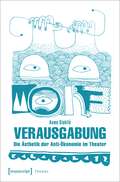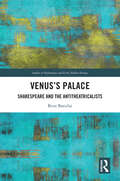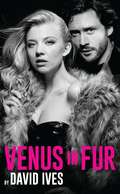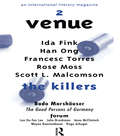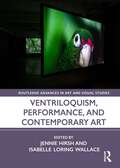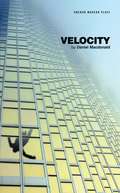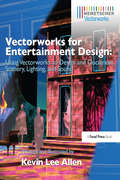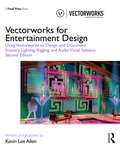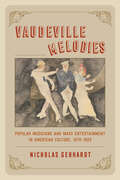- Table View
- List View
Verausgabung: Die Ästhetik der Anti-Ökonomie im Theater (Theater #99)
by Asma DiakitéWie ist angesichts der fortwährenden Dramatisierung der Politik und des allgegenwärtigen Diktats der Selbstwerdung eine ästhetische Praxis jenseits des Modells der Handlung noch möglich? In ihrer an Georges Bataille angelehnten Beschreibung einer ästhetischen Praxis als Verausgabung lotet Asma Diakité die Möglichkeiten des Theater-Raums als Ausnahme aus. Die Arbeit ist philosophische Reflexion und zugleich theaterwissenschaftliche Studie ästhetischer Praxis und Erfahrung. Sie macht es möglich, das Theater in Opposition zu einem am Vollbringen orientierten Konzept des Performativen (»kreative Selbstverwirklichung«) als »Kunst des Unterlassens« zu verstehen.
Vera Vera Vera (Modern Plays)
by Hayley SquiresThe boy who comes back from a war far away in a wooden box is glorified and called a hero. As the funeral plans are made in a small Kent town, his siblings squabble over who he was. Maybe the fanfare isn't needed for this heroic martyr.Vera Vera Vera is a blackly comic play about what we are willing to fight for. Her first work for the theatre, Hayley Squires is a bracing new voice, clear eyed and loud, looking at violence, neglect and apathy. Depicting a gritty slice of social realism, Vera Vera Vera portrays the disjunction between the lives of the surviving family against the memories and patriotic commemoration for the dead. Looking at drug addiction, crime, verbal and domestic abuse, engrained racism, the characters' downtrodden and trapped lives are exposed with honesty and verve.This brave and uncompromising play questions both the validity of the myth of the martyred soldier and the true worth of survival for those left behind.
Vera Vera Vera (Modern Plays)
by Hayley SquiresThe boy who comes back from a war far away in a wooden box is glorified and called a hero. As the funeral plans are made in a small Kent town, his siblings squabble over who he was. Maybe the fanfare isn't needed for this heroic martyr.Vera Vera Vera is a blackly comic play about what we are willing to fight for. Her first work for the theatre, Hayley Squires is a bracing new voice, clear eyed and loud, looking at violence, neglect and apathy. Depicting a gritty slice of social realism, Vera Vera Vera portrays the disjunction between the lives of the surviving family against the memories and patriotic commemoration for the dead. Looking at drug addiction, crime, verbal and domestic abuse, engrained racism, the characters' downtrodden and trapped lives are exposed with honesty and verve.This brave and uncompromising play questions both the validity of the myth of the martyred soldier and the true worth of survival for those left behind.
Venus’s Palace: Shakespeare and the Antitheatricalists (Studies in Performance and Early Modern Drama)
by Reut BarzilaiThis book lays bare the dialogue between Shakespeare and critics of the stage, and positions it as part of an ongoing cultural, ethical, and psychological debate about the effects of performance on actors and on spectators. In so doing, the book makes a substantial contribution both to the study of representations of theatre in Shakespeare’s plays and to the understanding of ethical concerns about acting and spectating—then, and now. The book opens with a comprehensive and coherent analysis of the main early modern English anxieties about theatre and its power. These are read against 20th- and 21st-century theories of acting, interviews with actors, and research into the effects of media representation on spectator behaviour, all of which demonstrate the lingering relevance of antitheatrical claims and the personal and philosophical implications of acting and spectating. The main part of the book reveals Shakespeare’s responses to major antitheatrical claims about the powerful effects of poetry, music, playacting, and playgoing. It also demonstrates the evolution of Shakespeare’s view of these claims over the course of his career: from light-hearted parody in A Midsummer Night’s Dream, through systematic contemplation in Hamlet, to acceptance and dramatization in The Tempest. This study will be of great interest to scholars and students of theatre, English literature, history, and culture.
Venus’s Palace: Shakespeare and the Antitheatricalists (Studies in Performance and Early Modern Drama)
by Reut BarzilaiThis book lays bare the dialogue between Shakespeare and critics of the stage, and positions it as part of an ongoing cultural, ethical, and psychological debate about the effects of performance on actors and on spectators. In so doing, the book makes a substantial contribution both to the study of representations of theatre in Shakespeare’s plays and to the understanding of ethical concerns about acting and spectating—then, and now. The book opens with a comprehensive and coherent analysis of the main early modern English anxieties about theatre and its power. These are read against 20th- and 21st-century theories of acting, interviews with actors, and research into the effects of media representation on spectator behaviour, all of which demonstrate the lingering relevance of antitheatrical claims and the personal and philosophical implications of acting and spectating. The main part of the book reveals Shakespeare’s responses to major antitheatrical claims about the powerful effects of poetry, music, playacting, and playgoing. It also demonstrates the evolution of Shakespeare’s view of these claims over the course of his career: from light-hearted parody in A Midsummer Night’s Dream, through systematic contemplation in Hamlet, to acceptance and dramatization in The Tempest. This study will be of great interest to scholars and students of theatre, English literature, history, and culture.
Venus in Fur: A Play (Oberon Modern Plays)
by David Ives‘You don’t have to tell me about sadomasochism. I’m in the theatre.’Enigmatic actress Vanda Jordan appears unannounced for an audition with director Thomas Novachek. She’s determined to land the leading role in his new production – despite seeming wrong for the part. Over one evening in downtown Manhattan their charged meeting becomes a seductive dance to the end. Intoxicating, erotic, highly charged, Venus In Fur is a dark comedy about desire, fantasy, and love.
Venue 2
by BrenkmanFirst Published in 1998. Routledge is an imprint of Taylor & Francis, an informa company.
Venue 2
by BrenkmanFirst Published in 1998. Routledge is an imprint of Taylor & Francis, an informa company.
Ventriloquism, Performance, and Contemporary Art (Routledge Advances in Art and Visual Studies)
by Jennie Hirsh Isabelle Loring WallaceVentriloquism, Performance, and Contemporary Art volume calls attention to the unexpected prevalence of ventriloqual motifs and strategies within contemporary art. Engaging with issues of voice, embodiment, power, and projection, the case studies assembled in this volume span a range of media from painting, sculpture, and photography to installation, performance, architecture, and video. Importantly, they both examine and enact ventriloqual practices, and do so as a means of interrogating and performatively bearing out contemporary conceptions of authorship, subjectivity, and performance. Put otherwise, the chapters in this book oscillate seamlessly between art history, theory, and criticism through both analytical and performative means. Across twelve essays on ventriloquism in contemporary art, the authors, who are curators, historians, and artists, shine light on this outdated practice, repositioning it as a conspicuous and meaningful trend within a range of artistic practices today. This book will be of interest to scholars working in art history, contemporary art, media studies, performance, museum/curatorial studies, and theater.
Ventriloquism, Performance, and Contemporary Art (Routledge Advances in Art and Visual Studies)
by Jennie Hirsh Isabelle Loring WallaceVentriloquism, Performance, and Contemporary Art volume calls attention to the unexpected prevalence of ventriloqual motifs and strategies within contemporary art. Engaging with issues of voice, embodiment, power, and projection, the case studies assembled in this volume span a range of media from painting, sculpture, and photography to installation, performance, architecture, and video. Importantly, they both examine and enact ventriloqual practices, and do so as a means of interrogating and performatively bearing out contemporary conceptions of authorship, subjectivity, and performance. Put otherwise, the chapters in this book oscillate seamlessly between art history, theory, and criticism through both analytical and performative means. Across twelve essays on ventriloquism in contemporary art, the authors, who are curators, historians, and artists, shine light on this outdated practice, repositioning it as a conspicuous and meaningful trend within a range of artistic practices today. This book will be of interest to scholars working in art history, contemporary art, media studies, performance, museum/curatorial studies, and theater.
Venice Saved
by Simone WeilTowards the end of her life, the French philosopher and mystic Simone Weil (1909-43) was working on a tragedy, Venice Saved. Appearing here in English for the first time, this play explores the realisation of Weil's own thoughts on tragedy. A figure of affliction, a central theme in Weil's religious metaphysics, the central character offers a unique insight into Weil's broader philosophical interest in truth and justice, and provides a fresh perspective on the wider conception of tragedy itself.The play depicts the plot by a group of Spanish mercenaries to sack Venice in 1618 and how it fails when one conspirator, Jaffier, betrays them to the Venetian authorities, because he feels compassion for the city's beauty. The edition includes notes on the play by the translators as well as introductory material on: the life of Weil; the genesis and purport of the play; Weil and the tragic; the issues raised by translating Venice Saved. With additional suggestions for further reading, the volume opens up an area of interest and research: the literary Weil.
Venice Saved
by Simone WeilTowards the end of her life, the French philosopher and mystic Simone Weil (1909-43) was working on a tragedy, Venice Saved. Appearing here in English for the first time, this play explores the realisation of Weil's own thoughts on tragedy. A figure of affliction, a central theme in Weil's religious metaphysics, the central character offers a unique insight into Weil's broader philosophical interest in truth and justice, and provides a fresh perspective on the wider conception of tragedy itself.The play depicts the plot by a group of Spanish mercenaries to sack Venice in 1618 and how it fails when one conspirator, Jaffier, betrays them to the Venetian authorities, because he feels compassion for the city's beauty. The edition includes notes on the play by the translators as well as introductory material on: the life of Weil; the genesis and purport of the play; Weil and the tragic; the issues raised by translating Venice Saved. With additional suggestions for further reading, the volume opens up an area of interest and research: the literary Weil.
The Venetian Origins of the Commedia dell'Arte
by Peter JordanThe Venetian Origins of the Commedia dell'Arte is a striking new enquiry into the late-Renaissance stirrings of professional secular comedy in Venice, and their connection to the development of what came to be known as the Commedia dell’Arte. The book contends that through a symbiotic collaboration between patrician amateurs and plebeian professionals, innovative forms of comedy developed in the Venice region, fusing ‘high’ and ‘low’ culture in a provocative mix that had a truly mass appeal. Rich with anecdotes, diary entries and literary – often ribald – comic passages, Peter Jordan's central argument has important implications for the study of Venetian art, popular theatre and European cultural history.
The Venetian Origins of the Commedia dell'Arte
by Peter JordanThe Venetian Origins of the Commedia dell'Arte is a striking new enquiry into the late-Renaissance stirrings of professional secular comedy in Venice, and their connection to the development of what came to be known as the Commedia dell’Arte. The book contends that through a symbiotic collaboration between patrician amateurs and plebeian professionals, innovative forms of comedy developed in the Venice region, fusing ‘high’ and ‘low’ culture in a provocative mix that had a truly mass appeal. Rich with anecdotes, diary entries and literary – often ribald – comic passages, Peter Jordan's central argument has important implications for the study of Venetian art, popular theatre and European cultural history.
Velocity (Oberon Modern Plays)
by Daniel Macdonald‘Everyone falls at the same rate. Isn’t that amazing? Everyone. Everything. A fat man. A little baby. A brick, a piece of paper, a penny. Amazing. Once acceleration gets a hold of you velocity just goes all fuckin’ nuts’ Dot doesn't hate her father, she just wants to explode him out of his office tower to shake things up. Set him off. See what happens. And get an "A" on her science project... Daring to challenge the law of physics, Dot interviews her flailing father and neurotic mother, as their world crashes to the ground. Just imagine. Your life in six seconds.
Vectorworks for Entertainment Design: Using Vectorworks to Design and Document Scenery, Lighting, and Sound
by Kevin Lee AllenThe first book in the industry tailored specifically for the entertainment professional, Vectorworks for Entertainment Design covers the ins and outs of Vectorworks software for lighting, scenic, and sound design. With a detailed look at the design process, from idea to development, to the documentation necessary for execution, Vectorworks for Entertainment Design will encourage you to create your own process and workflow through exercises that build on one another. The text stresses the process of developing an idea, visualizing it, and evolving it for presentation, documentation, or drafting. The author focuses on both the technical how-to and the art of design, giving you the tools you need to learn and then use the application professionally. Fully illustrated with step-by-step instructions, it contains inspirational work from Broadway, major regional companies, and non-theatrical, entertainment design.
Vectorworks for Entertainment Design: Using Vectorworks to Design and Document Scenery, Lighting, and Sound
by Kevin Lee AllenThe first book in the industry tailored specifically for the entertainment professional, Vectorworks for Entertainment Design covers the ins and outs of Vectorworks software for lighting, scenic, and sound design. With a detailed look at the design process, from idea to development, to the documentation necessary for execution, Vectorworks for Entertainment Design will encourage you to create your own process and workflow through exercises that build on one another. The text stresses the process of developing an idea, visualizing it, and evolving it for presentation, documentation, or drafting. The author focuses on both the technical how-to and the art of design, giving you the tools you need to learn and then use the application professionally. Fully illustrated with step-by-step instructions, it contains inspirational work from Broadway, major regional companies, and non-theatrical, entertainment design.
Vectorworks for Entertainment Design: Using Vectorworks to Design and Document Scenery, Lighting, Rigging and Audio Visual Systems
by Kevin Lee AllenVectorworks for Entertainment Design is the first book in the industry tailored for the entertainment professional. This second edition has been extensively revised and updated, covering the most current details of the Vectorworks software for scenery, lighting, sound, and rigging. With a focused look at the production process from ideation to development to documentation required for proper execution, the book encourages readers to better create their own processes and workflows through exercises that build on one another. This new edition introduces Braceworks, SubDivision modeling, and scripting using the Marionette tool, and covers new tools such as Video Camera, Deform Tool, Camera Match, Schematic Views, and Object Styles. Fully illustrated with step-by-step instructions, this volume contains inspirational and aspirational work from Broadway, Concerts, Regional Theatre, Dance, and Experiential Entertainment. Exploring both the technical how-to and the art of design, this book provides Theatre and Lighting Designers with the tools to learn about the application and use it professionally. Vectorworks for Entertainment Design also includes access to downloadable resources such as exercise files and images to accompany projects discussed within the book.
Vectorworks for Entertainment Design: Using Vectorworks to Design and Document Scenery, Lighting, Rigging and Audio Visual Systems
by Kevin Lee AllenVectorworks for Entertainment Design is the first book in the industry tailored for the entertainment professional. This second edition has been extensively revised and updated, covering the most current details of the Vectorworks software for scenery, lighting, sound, and rigging. With a focused look at the production process from ideation to development to documentation required for proper execution, the book encourages readers to better create their own processes and workflows through exercises that build on one another. This new edition introduces Braceworks, SubDivision modeling, and scripting using the Marionette tool, and covers new tools such as Video Camera, Deform Tool, Camera Match, Schematic Views, and Object Styles. Fully illustrated with step-by-step instructions, this volume contains inspirational and aspirational work from Broadway, Concerts, Regional Theatre, Dance, and Experiential Entertainment. Exploring both the technical how-to and the art of design, this book provides Theatre and Lighting Designers with the tools to learn about the application and use it professionally. Vectorworks for Entertainment Design also includes access to downloadable resources such as exercise files and images to accompany projects discussed within the book.
Vaudeville Melodies: Popular Musicians and Mass Entertainment in American Culture, 1870-1929
by Nicholas GebhardtIf you enjoy popular music and culture today, you have vaudeville to thank. From the 1870s until the 1920s, vaudeville was the dominant context for popular entertainment in the United States, laying the groundwork for the music industry we know today. In Vaudeville Melodies, Nicholas Gebhardt introduces us to the performers, managers, and audiences who turned disjointed variety show acts into a phenomenally successful business. First introduced in the late nineteenth century, by 1915 vaudeville was being performed across the globe, incorporating thousands of performers from every branch of show business. Its astronomical success relied on a huge network of theatres, each part of a circuit and administered from centralized booking offices. Gebhardt shows us how vaudeville transformed relationships among performers, managers, and audiences, and argues that these changes affected popular music culture in ways we are still seeing today. Drawing on firsthand accounts, Gebhardt explores the practices by which vaudeville performers came to understand what it meant to entertain an audience, the conditions in which they worked, the institutions they relied upon, and the values they imagined were essential to their success.
Vaudeville Melodies: Popular Musicians and Mass Entertainment in American Culture, 1870-1929
by Nicholas GebhardtIf you enjoy popular music and culture today, you have vaudeville to thank. From the 1870s until the 1920s, vaudeville was the dominant context for popular entertainment in the United States, laying the groundwork for the music industry we know today. In Vaudeville Melodies, Nicholas Gebhardt introduces us to the performers, managers, and audiences who turned disjointed variety show acts into a phenomenally successful business. First introduced in the late nineteenth century, by 1915 vaudeville was being performed across the globe, incorporating thousands of performers from every branch of show business. Its astronomical success relied on a huge network of theatres, each part of a circuit and administered from centralized booking offices. Gebhardt shows us how vaudeville transformed relationships among performers, managers, and audiences, and argues that these changes affected popular music culture in ways we are still seeing today. Drawing on firsthand accounts, Gebhardt explores the practices by which vaudeville performers came to understand what it meant to entertain an audience, the conditions in which they worked, the institutions they relied upon, and the values they imagined were essential to their success.
Vaudeville Melodies: Popular Musicians and Mass Entertainment in American Culture, 1870-1929
by Nicholas GebhardtIf you enjoy popular music and culture today, you have vaudeville to thank. From the 1870s until the 1920s, vaudeville was the dominant context for popular entertainment in the United States, laying the groundwork for the music industry we know today. In Vaudeville Melodies, Nicholas Gebhardt introduces us to the performers, managers, and audiences who turned disjointed variety show acts into a phenomenally successful business. First introduced in the late nineteenth century, by 1915 vaudeville was being performed across the globe, incorporating thousands of performers from every branch of show business. Its astronomical success relied on a huge network of theatres, each part of a circuit and administered from centralized booking offices. Gebhardt shows us how vaudeville transformed relationships among performers, managers, and audiences, and argues that these changes affected popular music culture in ways we are still seeing today. Drawing on firsthand accounts, Gebhardt explores the practices by which vaudeville performers came to understand what it meant to entertain an audience, the conditions in which they worked, the institutions they relied upon, and the values they imagined were essential to their success.
Vaudeville Melodies: Popular Musicians and Mass Entertainment in American Culture, 1870-1929
by Nicholas GebhardtIf you enjoy popular music and culture today, you have vaudeville to thank. From the 1870s until the 1920s, vaudeville was the dominant context for popular entertainment in the United States, laying the groundwork for the music industry we know today. In Vaudeville Melodies, Nicholas Gebhardt introduces us to the performers, managers, and audiences who turned disjointed variety show acts into a phenomenally successful business. First introduced in the late nineteenth century, by 1915 vaudeville was being performed across the globe, incorporating thousands of performers from every branch of show business. Its astronomical success relied on a huge network of theatres, each part of a circuit and administered from centralized booking offices. Gebhardt shows us how vaudeville transformed relationships among performers, managers, and audiences, and argues that these changes affected popular music culture in ways we are still seeing today. Drawing on firsthand accounts, Gebhardt explores the practices by which vaudeville performers came to understand what it meant to entertain an audience, the conditions in which they worked, the institutions they relied upon, and the values they imagined were essential to their success.
Vaudeville Melodies: Popular Musicians and Mass Entertainment in American Culture, 1870-1929
by Nicholas GebhardtIf you enjoy popular music and culture today, you have vaudeville to thank. From the 1870s until the 1920s, vaudeville was the dominant context for popular entertainment in the United States, laying the groundwork for the music industry we know today. In Vaudeville Melodies, Nicholas Gebhardt introduces us to the performers, managers, and audiences who turned disjointed variety show acts into a phenomenally successful business. First introduced in the late nineteenth century, by 1915 vaudeville was being performed across the globe, incorporating thousands of performers from every branch of show business. Its astronomical success relied on a huge network of theatres, each part of a circuit and administered from centralized booking offices. Gebhardt shows us how vaudeville transformed relationships among performers, managers, and audiences, and argues that these changes affected popular music culture in ways we are still seeing today. Drawing on firsthand accounts, Gebhardt explores the practices by which vaudeville performers came to understand what it meant to entertain an audience, the conditions in which they worked, the institutions they relied upon, and the values they imagined were essential to their success.
Vaudeville Melodies: Popular Musicians and Mass Entertainment in American Culture, 1870-1929
by Nicholas GebhardtIf you enjoy popular music and culture today, you have vaudeville to thank. From the 1870s until the 1920s, vaudeville was the dominant context for popular entertainment in the United States, laying the groundwork for the music industry we know today. In Vaudeville Melodies, Nicholas Gebhardt introduces us to the performers, managers, and audiences who turned disjointed variety show acts into a phenomenally successful business. First introduced in the late nineteenth century, by 1915 vaudeville was being performed across the globe, incorporating thousands of performers from every branch of show business. Its astronomical success relied on a huge network of theatres, each part of a circuit and administered from centralized booking offices. Gebhardt shows us how vaudeville transformed relationships among performers, managers, and audiences, and argues that these changes affected popular music culture in ways we are still seeing today. Drawing on firsthand accounts, Gebhardt explores the practices by which vaudeville performers came to understand what it meant to entertain an audience, the conditions in which they worked, the institutions they relied upon, and the values they imagined were essential to their success.
